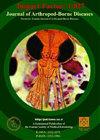班加罗尔附近农村地区登革热和基孔肯雅病负担的空间分布图--一项描述性横断面研究
IF 0.6
4区 医学
Q4 PARASITOLOGY
引用次数: 0
摘要
背景:印度各地区登革热和基孔肯雅病的负担很少量化,在 Covid19 大流行期间和基于医院的研究中更是如此。本研究旨在评估登革热和基孔肯雅病在主要研究地区的流行情况,并利用量子地理信息系统(QGIS)直观显示登革热和基孔肯雅病病例的空间分布情况。研究方法这项描述性横断面研究是在班加罗尔附近一所医学院农村实习区内的村庄人口中进行的。通过简单随机抽样方法共选取了 31 个村庄,并通过家访对 3356 名受试者进行了调查。使用 QGIS 绘制了病例的空间分布图。结果接受调查的 3356 人中,登革热和基孔肯雅病的发病率分别为 1.13% 和 0.02%。登革热和基孔肯雅病的总发病率为 1.16%。所有 39 个病例(100%)均报告发烧,31 个病例(79.5%)报告肌痛,22 个病例(56.4%)报告关节痛。QGIS 支持绘制病例空间分布图,在研究区域内未发现病例聚集现象。结论对登革热和基孔肯雅病的报告不足,需要加强农村地区的监测系统。研究发现,QGIS 在绘制病例空间分布图方面非常有用,而且没有发现病例聚集现象。本文章由计算机程序翻译,如有差异,请以英文原文为准。
Spatial Mapping the Dengue and Chikungunya Burden in a Rural Area near Bangalore- a Descriptive Cross-Sectional Study
Background: The burden of dengue and chikungunya diseases across geographical regions of India is poorly quantified more so during Covid19 pandemic and from hospital-based studies. The objective was to assess the prevalence of dengue and chikungunya in the study mainly area and to visualize the spatial distribution of dengue and chikungunya cases using the Quantum Geographic Information System (QGIS).
Methods: This descriptive cross-sectional study was conducted among the population in villages coming under a medical college’s rural field practice area near Bangalore. A total of 31 villages were selected through a simple random sampling method and 3356 subjects were surveyed through household visits. QGIS was used for spatial mapping of cases.
Results: 3356 subjects were surveyed, and the prevalence of dengue and chikungunya was 1.13% and 0.02%, respectively. The overall prevalence of dengue and chikungunya cases together was 1.16%. All 39 (100%) cases had reported fever and 31 cases (79.5%) reported myalgia followed by arthralgia 22 (56.4%). QGIS supported spatial mapping of the cases and no clustering of cases was found in the study area.
Conclusion: The burden of dengue and chikungunya is under reported, and the surveillance system needs to be strengthened in the rural area. QGIS was found to be useful in the spatial mapping of the cases and there was no clustering of cases observed.
求助全文
通过发布文献求助,成功后即可免费获取论文全文。
去求助
来源期刊

Journal of Arthropod-Borne Diseases
PUBLIC, ENVIRONMENTAL & OCCUPATIONAL HEALTH-PARASITOLOGY
CiteScore
2.00
自引率
11.10%
发文量
17
审稿时长
8 weeks
期刊介绍:
The journal publishes original research paper, short communication, scientific note, case report, letter to the editor, and review article in English. The scope of papers comprises all aspects of arthropod borne diseases including:
● Systematics
● Vector ecology
● Epidemiology
● Immunology
● Parasitology
● Molecular biology
● Genetics
● Population dynamics
● Toxicology
● Vector control
● Diagnosis and treatment and other related subjects.
 求助内容:
求助内容: 应助结果提醒方式:
应助结果提醒方式:


